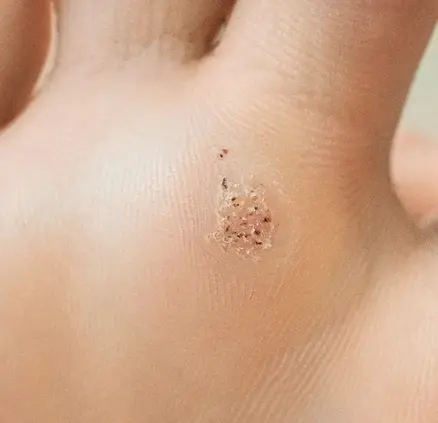
Verruca
What is a Verruca?
A verruca is a wart that appears on the foot, caused by the Human Papilloma Virus (HPV). It often develops on the soles or toes and may be painful when walking or standing.
The virus enters the skin through tiny cuts or abrasions. It is commonly picked up in swimming pools, communal showers, gym changing rooms or walking barefoot in public places.
Although harmless, verrucae can spread to others or to other areas of your own foot. Early treatment reduces risk of transmission.
What Does It Look Like?
-
Rough, grainy skin.
-
Black dots (clotted blood vessels) inside.
-
May appear alone or in clusters.
-
Flat and hard if located on weight-bearing areas.
Our Specialist Verruca Treatment Includes:
Each treatment option is chosen appropriately for the patient, including the option of no treatment. Patient’s medical history, health status, activity level, area of Verruca pedis, tissue viability and their availability for weekly treatments are considered. Surrounding skin is protected with soft yellow paraffin or zinc oxide tape to avoid unnecessary damage to the health skin.
Note: All verrucae require debridement, which may result in bleeding to initiate the immune system.
Cryotherapy (Thermal Treatment):
The liquid nitrogen is sprayed on to the wart. It is very cold, the freezing and thawing destroys the wart tissue. To clear the wart fully it can need up to 3-4 treatment sessions, sometimes more. Each treatment session is 2 weeks apart.
Freezing treatment can be painful. Sometimes a small blister develops for a day or so on the nearby skin after treatment. Also, there is a slight risk of scarring the nearby skin or damaging underlying tissues.
It is not suitable for younger children due to their developmental stage, or for people with poor circulation, impaired sensation, raynauds (hypersensitivity to cold).
The patient is seen 7-10 days after the procedure/treatment to review the skin. In most cases nothing obvious happen, but in some cases slight blistering occur. This blister then de-roofed, drained and dressed with a dry dressing.
AFTERCARE AT HOME:
If discomfort/pain continues after treatment or you start to develop severe pain, spreading redness or swelling, then you may be having allergic reaction or infection. DO NOT IGNORE IT. You should follow the steps below immediately:
-
Take off any dressing that have been applied to your foot.
-
Ring GP or 111 for further advice.
Silver Nitrate (Caustic Treatment): Silver nitrate is a chemical, which works by destroying the tissue on the surface layers of the verrucae. A silver nitrate 95% stick is used.
It requires 9 to 10 weekly appointments.
AFTERCARE AT HOME:
If discomfort/pain continues after treatment or you start to develop severe pain, spreading redness or swelling, then you may be having allergic reaction or infection. DO NOT IGNORE IT. You should follow the steps below immediately:
-
Take off any dressing that have been applied to your foot.
-
Prepare a clean basin with cool water and add 2-3 tablespoons of salt.
-
Soak your painful foot in the footbath for around 15 mins or until pain goes away
-
If the pain does not go away, you should ring GP or 111 for further advice.
Verrutop (Nitric acid, Zn and Cu salts complex): It is different to other caustic agents as it is a combination of organic and inorganic acids plus metal ions which act in a different way to nitric acid alone. This nitri-zinc complex creates a redox reaction on the wart, causing the production of nitrates which act to denature viral protein and destroy the wart tissue.
Two-week gap between each appointment and 3 to 4 sessions are recommended to fully resolve the verruca.
AFTERCARE AT HOME:
If discomfort/pain continues after treatment or you start to develop severe pain, spreading redness or swelling, then you may be having allergic reaction or infection. DO NOT IGNORE IT. You should follow the steps below immediately:
-
Take off any dressing that have been applied to your foot.
-
Prepare a clean basin with cool water and add 2-3 tablespoons of salt.
-
Soak your painful foot in the footbath for around 15 mins or until pain goes away
-
If the pain does not go away, you should ring GP or 111 for further advice.
